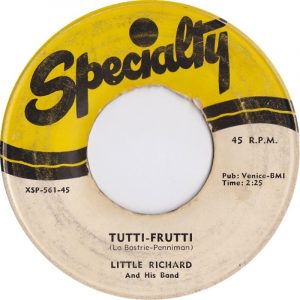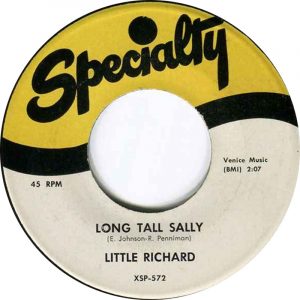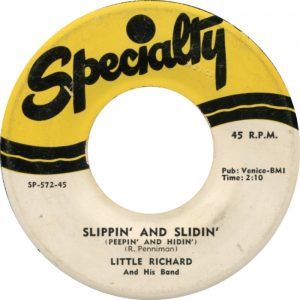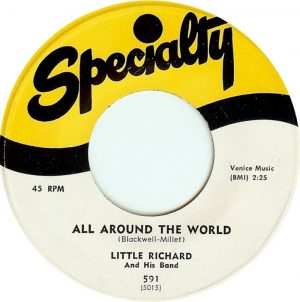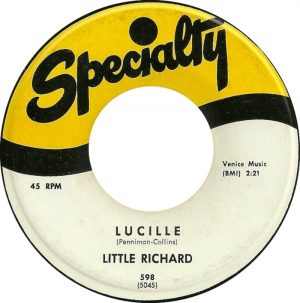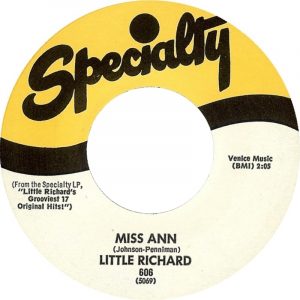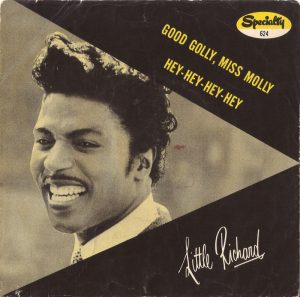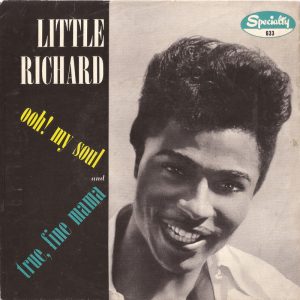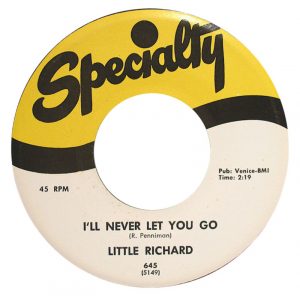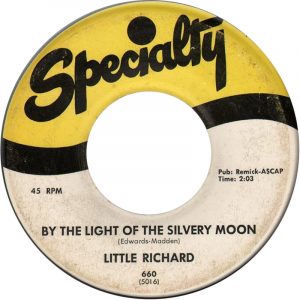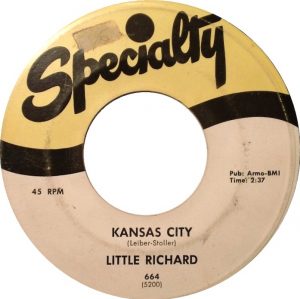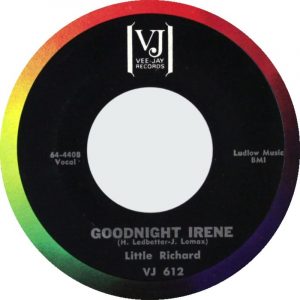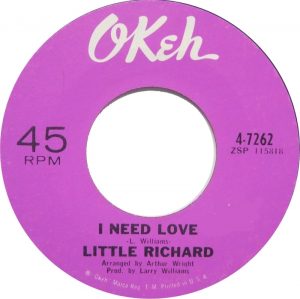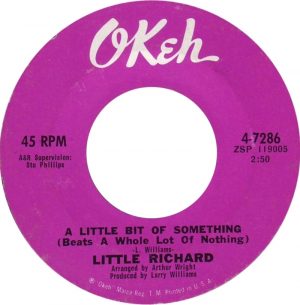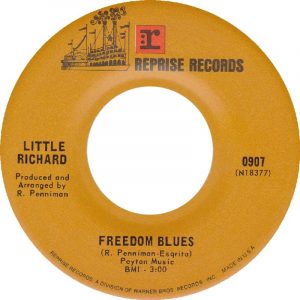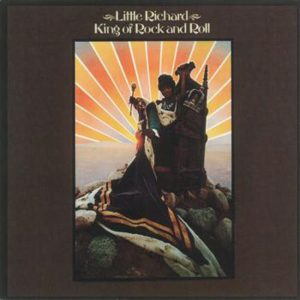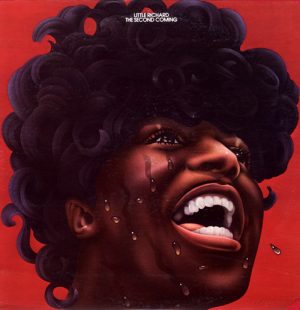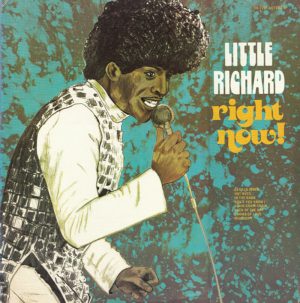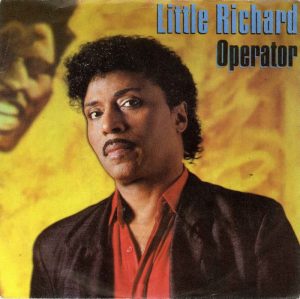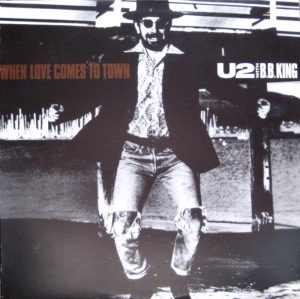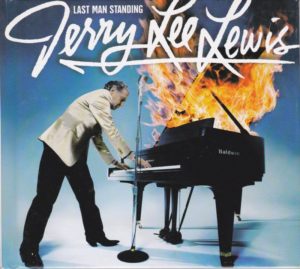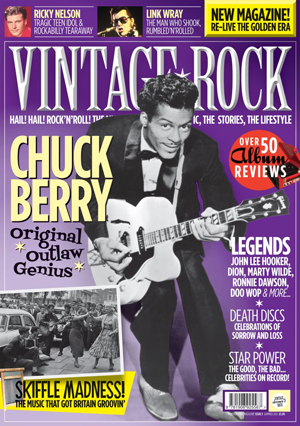In Vintage Rock’s Top 40 Little Richard we highlight how, from his origins in R&B and blues, the Georgia Peach quickly evolved into an untamed rock’n’roll superpower, undeniably vital to all who followed – words by Ian Wade
Little Richard was never one for hiding his light under a bushel – and why should he? “I’m a living legend!” he proclaimed grandiloquently to Smash Hits in 1986, discussing his comeback around the time of the album Lifetime Friend. “I am a creator of a music that’s alive all around the world.
“And when I see Prince… that’s Little Richard. David Bowie, Michael Jackson, Boy George… when I see these people it makes me feel good that I contributed, that my life has not been in vain, that I came this way and left something, and I left my mark and it wasn’t the wrong kind of mark. It was a mark of hope, of happiness, of JOY!”
Few could argue with him on that. Little Richard opened the doors for these turns and many more, and continues to do so for anyone setting foot on stage clad in more than a black T-shirt and jeans. He’s been there all along, inspiring Elvis Presley, The Beatles, Elton John, The Rolling Stones, Otis Redding, Sam Cooke – and that’s just in the first decade of hits. His flamboyance, spirit and sheer lifeforce has been an inspiration for all that followed. It’s hard to explain just how shocking this made-up and high-haired rock and roller looked to the parents of the kids eating up his pop filth.
The Architect Of Rock’N’Roll
The Richard Wayne Penniman discography is, at first glance, a vast and foreboding selection, but once you tap into it a bit you’ll see that much of that daunting list is down to the presence of reissues and re-recordings. His career is pockmarked with one-off contracts with assorted labels, and each one of these would generally encourage him to revisit his rock’n’roll era. Richard, in fact, would go back and forth between gospel/ religious recordings and general pop-related material. The only main longterm contract where he’d produce magic – indeed, conjure up the formidable “A-wop-bop-a-loo-bop-a-wop-bom-bom!” – would be on the Los Angeles-based Specialty Records.
What is also interesting are the chart positions. Only three singles made it to a No.1 spot, and those were on the Billboard R&B charts. His biggest success on the Billboard 100 would be the No.8 of Keep A-Knockin’, and in the UK it would be the less characteristic Baby Face that would be the biggest hit.
To narrow this discography down to 40 essential tracks wasn’t particularly easy, but we focused on the original recordings; many of his early hits exist out there in up to three or four variants. We also tried to keep it to mainly self-written compositions rather than covers; there are a few exceptions, but everybody was covering each other back in the early phases of rock, and while Richard may have scored hits with some, it’s his work that edged them in originality. While many have covered Little Richard’s songs, few could make them even remotely their own. We’ve also steered clear of the gospel releases, those times when Richard turned his back on the music that made his name. Here you’ll find blues, jazz, soul, funk, shiny ’80s pop, duets, a remix… and a whole lotta rock’n’roll.
TAXI BLUES
Recorded 1951
The all-important debut single for Little Richard, and you can see the genesis of the rocker that would eventually emerge over the next few years. Unlike the material that was shortly to follow, this jump-jazz blues number has the piano merely plinking demurely away in the background. Knowing what he would go on to do with his voice, his vocal operatics are restrained: frankly, this could almost be anyone. It was written by British-born husband and wife duo Jane and Leonard Weather, who’d written a book entitled The Biographical Encyclopedia Of Jazz, so they knew a thing or two. It bypassed all the charts when released in November 1951 on RCA Victor.
TUTTI FRUTTI
Recorded 1955
Not just a record, more like a bomb, Tutti Frutti remains a total blast 60 years on from when it practically invented rock’n’roll with its iconic opening. Specialty liked what they heard from Richard’s demo tape, but during his first session he wasn’t quite catching on fire. Frustrated, he banged out a piece of hell-raising suggestivity he’d been performing in shows. After Robert ‘Bumps’ Blackwell heard this, he suggested Richard tone it down a tad, and got Dorothy LaBostrie to change the lines about various sexual happenings into something less fruity. Forget Pat Boone’s pale version: this is the one that we’re still talking about all these decades later.
LONG TALL SALLY (THE THING)
Recorded 1956
Originally just called The Thing, Long Tall Sally sealed the deal on Little Richard’s new success and his move to Specialty. Richard spots Sally getting up to something unsavoury with Uncle John and rather than scold them when he suggests telling Aunt Mary, he sounds to be rather more in favour of it (Lord knows what the “bald head” is, but it gives off the air of something freakish). It became his first #1 record in March of 1956, and spent a whopping 19 weeks on top of the R&B charts. Both Elvis and The Beatles covered the song, with the four-piece making it part of their early incarnation and then scoring a No.1 on the EP charts with it in 1964.
SLIPPIN’ AND SLIDIN’
Recorded 1956
This was the B-side to the force of nature that was Long Tall Sally, as well as featuring on Here’s Little Richard, a flawless collection of his best sides. Originally the title of a song written by Maxwell Davis and performed by Calvin Boze and His All Stars, and released in May 1951 by Aladdin Records, the song was described as “an engaging set of novelty lyrics, while the combo puts down a swingy, medium shuffle”. A slower R&B-esque version was recorded by Al Collins, while Eddie Bo changed the lyrics and called it I’m Wise. Richard took this template, sped it up and – as was the way back then – destroyed Bo’s version, which was released the week before.
RIP IT UP
Recorded 1956
This time-honoured tale of receiving wages on a Friday night and planning exactly how to blow them across the weekend was written by Robert Blackwell and John Marascalco. Rip It Up was the second of Little Richard’s three R&B chart toppers, and became near-ubiquitous during that era, with Elvis Presley, the Everly Brothers, Chuck Berry and Buddy Holly all covering it in various forms. Bill Haley and the Comets even had the audacity to release their own version that year, faring rather better in the UK than Richard himself had done, and they also performed it in the 1956 film Don’t Knock The Rock, in which Little Richard also appeared.
READY TEDDY
Recorded 1956
Ready Teddy was originally the B-side to Rip It Up, and just missed the Top 40 when it was released in 1956. It was co-written with John Marascalco and Robert Blackwell; “They brought me the words and I made up the melody and at the time I didn’t have sense enough to claim so much money, because I really made them hits,” Richard mourned to Rolling Stone in 1970. “I didn’t get the money, but I still have the freedom.” Although Elvis and Buddy Holly have recorded their own takes, and Italian star Adriano Celentano sang it in Fellini’s La Dolce Vita, Richard’s breathless, barnstorming couple of minutes remains the definitive version.
THE GIRL CAN’T HELP IT
Recorded 1956
This was the title song to the 1956 Jayne Mansfield film The Girl Can’t Help It, with words and music by songwriter Bobby Troup – also the composer of the classic (Get Your Kicks On) Route 66, as recorded by just about everyone. It hadn’t been originally meant to be rock and roll at all, as Fats Domino had originally been lined up to sing it. Little Richard pops up in the movie, as does Fats, Eddie Cochran, Julie London, Gene Vincent, and The Platters. The film bombed at the box office at the time, but a young John Lennon caught it during the summer of 1957 and it blew his mind, showing the stars that he worshipped were actual human beings… and thus began his music odyssey.
ALL AROUND THE WORLD
Recorded 1956
This is one of those numbers where Little Richard takes his flashy-shoed foot off the gas and slows things down, just a notch. That being said, it’s still quite the jiver. Basically, he’s stating what was now becoming the obvious; that all around the world, rock and roll is here to stay. Written by Robert Blackwell, the song would appear on the B-side of The Girl Can’t Help It, but it would also score a No.13 in its own right on the R&B charts, and in addition it turned up on Richard’s second self-titled album released in 1958 – although in the UK this long-player was known as Volume 2 to avoid confusion with the Camden-released debut.
LUCILLE
Recorded 1956
Lucille was co-written with one Albert Collins (not the noted Texas blues guitarist), although initial pressings had Richard as the sole writer, as he had bought half the rights from Collins when he was incarcerated in Louisiana State prison. Now, though, Collins shares the credit. Lucille was the last of his R&B chart-toppers from the imperial phase he and his regular band of Lee Allen, Alvin ‘Red’ Tyler, Roy Montrell, Frank Fields and Earl Palmer were enjoying at Specialty. A bluesier, more bassy-toned affair than previous hits, recorded in a lower register, it foreshadowed the way that rock music would be heading in the next decade.
SEND ME SOME LOVIN’
Recorded 1956
Ready Teddy’s John S Marascalco co-wrote Send Me Some Lovin’ with Leo Price, and this slightly less aggressive number became the B-side to the No.1 Lucille and also grabbed the R&B No.3 slot in its own right. While Richard had rock’n’roll pretty much covered, his influence on soul music is sometimes overlooked, yet this song was adaptable enough to be covered by Stevie Wonder, John Lennon, Brenda Lee, Otis Redding, and Sam Cooke… who said in 1962, “He has done so much for our music,” acknowledging both what Richard had done in moving soul music to the fore and the role he had played in affecting America’s growing racial acceptance.
JENNY, JENNY
Recorded 1956
Jenny, Jenny featured the remarkable studio musicians who gathered around Cosimo Matassa’s J&M Studios in New Orleans. They had been recording with Little Richard since September 1955, and this song showcases most notably Lee Allen’s tenor sax and Alvin ‘Red’ Tyler’s baritone. Their input manages to transform an otherwise simple number – where Richard is basically repeating the few lyrics again and again – into one of the most effortless and thrilling of his early hits. The tune would go on to be re-recorded several times for various labels as live versions, and a studio take dating to his Vee-Jay period is available on the 1971 album Mr Big.
MISS ANN
Recorded 1956
Released as the B-side to Jenny, Jenny, Miss Ann is believed to have been written about Ann Johnson from Macon, Georgia, who along with her husband Enotris Johnson took in Little Richard after he was kicked out of his family home for outraging his father’s sensibilities. The Johnsons also ran the Tick Tock Club, where Richard first performed. Enotris was credited as co-writer on this as well as several other cuts including Long Tall Sally – although it’s odd that a Seventh Day Adventist should have generated such juicy verbiage, so it may be that Richard was merely being charitable. Reaching No.6 on the R&B lists, it also featured on Here’s Little Richard.
KEEP A KNOCKIN’
Recorded 1957
The John Bonham drum intro of Led Zeppelin’s Rock And Roll is a direct copy/homage of Charles Connor’s ‘flattened out double shuffle’ intro to Keep A-Knockin’, and it’s he who is the real star here. Connor also busied himself with James Brown’s band, and the Godfather of Soul himself described Connor as the very first drummer to inject funk into his rhythms. The song is usually assumed to have mutated from a 1928 original by Perry Bradford and J Mayo Williams via 1930s versions by James Wiggins, Lil’ Johnson, Milton Brown and Louis Jordan; Richard added his name to the credits to what has become the standard when he released his version.
CAN’T BELIEVE YOU WANNA LEAVE
Recorded 1956
This was the flipside to Keep A-Knockin’ when it was first released in 1957, and also featured on Here’s Little Richard. Can’t Believe You Wanna Leave was written by Leo Price, the younger brother of Lawdy Miss Clawdy hitmaker Lloyd Price. In fact, Lloyd himself had been quite the thing before he’d been drafted to fight in Korea, allowing Little Richard to sweep in and steal his thunder. Leo also penned Send Me Some Lovin’ for Little Richard, which went on to be covered by Buddy Holly, Brenda Lee and Sam Cooke; Can’t Believe You Wanna Leave, meanwhile, was reinterpreted by Gene Vincent and, much later, by Shakin’ Stevens.
GOOD GOLLY, MISS MOLLY
Recorded 1956
Written by John Marascalco and Robert Blackwell, Little Richard had first heard the phrase “Good golly, Miss Molly” from a Southern DJ named Jimmy Pennick, and half-inched Ike Turner’s piano intro from Jackie Brenston’s Rocket 88. “I always liked that record,” Richard admitted, “and I used to use the riff in my act, so when we were looking for a lead-in to Good Golly, Miss Molly, I did that and it fit.” He was not the first to release it – that accolade went to The Valiants, who had imitated Little Richard’s as-then-unreleased version in 1957. However, Richard’s single release would dwarf their achievements and provide him with one of his biggest hits.
HEY-HEY-HEY-HEY (GOIN’ BACK TO BIRMINGHAM)
Recorded 1956
Little Richard knocked out two versions of Lieber and Stoller’s Kansas City during 1955. The first was fairly faithful to the original Little Willie Littlefield recording (but it remained unreleased until 1970). On the second version – which shared Kansas City’s introductory guitar riff and distinctive drum roll – Richard reworked the song, adding a shout of “hey hey hey hey” and claiming a sole writing credit. When The Beatles covered Kansas City on Beatles For Sale, Richard’s publisher issued a complaint claiming that they’d also covered Hey-Hey-Hey-Hey by default… and the credit was changed.
OOH! MY SOUL
Recorded 1957
The parping, pounding Ooh! My Soul first appeared as a track on Little Richard’s eponymous second album. The tune was subsequently recorded by The Beatles in 1963 for the BBC Playhouse Theatre in Manchester and later released as part of a compilation in 1994, The Beatles At The BBC; another version came courtesy of psychedelic rockers Big Brother and the Holding Company in 1966, and David Essex even referenced it – alongside many other rock’n’roll songs – on his 1973 hit Rock On. It was Little Richard’s first comparative flop, reaching No.35 and missing the R&B Top 10 altogether. Never mind… it fared a little better in the UK, scoring a No.22 placing.
I’LL NEVER LET YOU GO (BOO HOO HOO HOO)
Recorded 1957
Reaching No.2 in the UK – his highest position in the UK charts – when released as the B-side to his version of the standard Baby Face, and cropping up on his album Volume 2 in July 1958, I’ll Never Let You Go (Boo Hoo Hoo Hoo) was a self-written number in a rolling, bluesy, New Orleanian Fats Domino-style vein which tackled the ever-popular subject of simple undying affection… and with Little Richard managing to make the most out of the slender lyrics with trademark yelps and shrieks, it was a far more satisfying proposition than its rather more showbizzy A-side.
BY THE LIGHT OF THE SILVERY MOON
Recorded 1959
A familiar standard, written by Gus Edwards and Edward Madden and first performed as part of the Ziegfeld Follies stage show of 1909, By The Light Of The Silvery Moon had been sung by Bing Crosby, Fats Waller and Doris Day. It became a No.17 hit for Little Richard in the UK in 1959, and was later released as part of an EP from K-Tel’s Little Richard Live! 20 Super Hits in 1976, an album on which Richard went to Nashville and re-recorded his biggest Specialty hit. At the time, he claimed it would be the last time he would ever record rock’n’roll before giving it all up and dedicating his talents to God.
KANSAS CITY
Recorded 1955
This gets complicated. As with Hey-Hey-Hey-Hey, which – as we’ve seen – mutated from Little Richard’s version of Lieber & Stoller’s Kansas City, this was one of two versions he’d recorded during 1956 and was more in line with the original 1952 version by Little Willie Littlefield, then known as K C Loving. It’s one of Lieber & Stoller’s most-covered songs, and more than 300 versions are known to exist; Little Richard’s take had to contend with Wilbert Harrison’s chart-topping version, alongside three other remakes. Wilbert would also record an ‘answer song’ in 1960 called Goodbye Kansas City, but by that point the whole ‘Kansas City’ fad had passed.
BAMA LAMA BAMA LOO
Recorded 1964
Having bounced his way around a handful of labels, in 1964 Little Richard returned to the scene of so many of his past glories, Specialty Records, keen to recapture some of the old magic all over again. Bama Lama Bama Loo was a concerted attempt to reclaim both his rock and his roll. With demented shrieks, a hysterical delivery and liberal applications of the high-trilling “wooooo!” that The Beatles so artfully nabbed, it sounded more over-eager to please than the uninhibited, breakneck abandon of songs like Tutti Frutti. It did have the required effect, though: it saw Richard return to the US listings and it became a No.20 hit in the UK – his best chart returns after a six-year drought.
GOODNIGHT IRENE
Recorded 1964
This American folk standard – aka Irene, Goodnight – was originally written and performed by folk-blues legend Lead Belly, who’d crafted versions of it as early as 1908, but it would be his recording in 1933 for the Library of Congress that would prove to be the definitive one. Little Richard recorded his version for Vee-Jay as part of his first rock and roll album in five years, Little Richard Is Back (And There’s A Whole Lotta Shakin’ Goin’ On!). It was released as the B-side to the (almost) title track, and was later put out once again, in 1972, co-crediting the recently deceased Jimi Hendrix, who had played guitar on the track as a young unknown.
I DON’T KNOW WHAT YOU GOT BUT IT’S GOT ME
Recorded 1965
Bored of playing backline in the Isley Brothers, a young Maurice James started to play with Little Richard, and the man who was shortly to be infinitely better known as Jimi Hendrix was soon upstaging his employer. “People would scream and I thought they were screaming for me. I look over and they’re screaming for Jimi! So I had to darken the lights,” Richard complained. “He’d be playing the guitar with his teeth.” From the sides they would record together for Vee-Jay, the Don Covay-written I Don’t Know What You Got But It’s Got Me was by far the strongest, and reached No.12 on the R&B charts.
I NEED LOVE
Recorded 1966
Channelling the urgency of then-happening singers Arthur Conley and Otis Redding more than anything, Little Richard is at his soul peak on this Larry Williams-penned and produced groover. Poor Dog (Who Can’t Wag His Own Tail) – the lead single from The Explosive Little Richard – may have been the bigger hit, but I Need Love was the superior number. Though it appears on an album where he covers a number of much more famous songs such as Land of A Thousand Dances, Money and Function At The Junction, it’s on the lesser-known titles such as this that Richard really manages to stamp his inimitable mark and make them truly his own.
HURRY SUNDOWN
Recorded 1966
This 1966 song was written by Yip Harburg and Earl Robinson and first committed to wax by the noted folk-scare trio Peter, Paul and Mary – a disc which would be nominated for a Grammy for Best Folk Recording the next year. Little Richard’s version seemed to nod more towards gospel with a sleek Bacharach-style groove, and was recorded as part of the sessions for The Explosive Little Richard. It was omitted from the album, though, and cropped up as a B-side to the more soulful I Don’t Want To Discuss It, but it clearly proves that Richard was quite quick to adapt to changing styles… even if the record-buying public weren’t.
A LITTLE BIT OF SOMETHING (BEATS A WHOLE LOT OF NOTHING)
Recorded 1967
Little Richard goes Northern Soul? You’d better believe it. A Little Bit Of Something may have been just a one-off single in 1967, but its rarity status has elevated into something of a talcum powder wonder and copies now go for around £40. The B-side, a version of Berry Gordy’s Money, would appear on The Explosive Little Richard, which saw Richard veer further towards a more soul/Motown sound on a range of covers with the help of longtime friend Larry Williams and Johnny ‘Guitar’ Watson in the producers’ chairs. Those of us with less disposable income can find it on The Okeh Sessions collection.
BABY DON’T YOU TEAR MY CLOTHES
Recorded 1968
Little Richard was not one to be tied down to any one company for too long, and in 1967-’68 he laid down six sides for Brunswick Records and promptly left the label immediately after the sessions had been recorded. There had been plans for a live album – Little Richard Sings At The Aladdin – to follow, but it never materialised. Coupled with Stingy Jenny on its B-side, Baby Don’t You Tear My Clothes failed to chart on any list whatsoever, showing that, sadly, attempts to move on from the iconic rock and roll that had made his name weren’t quite working as he had hoped.
FREEDOM BLUES
Recorded 1970
The turn of the 1970s saw a lot of rock and rollers find themselves a new audience, having been rediscovered as the more lively and sparkly end of otherwise grotty hippy-infested festival bills such as Woodstock. On The Rill Thing, Richard’s first album for three years, he proves himself to be hip to the groovier end of country rock, and this cut – co-written with occasional collaborator Esquerita – is a Southern-drenched slice of wonder. “Freedom Blues is part civil-rights rallying cry, part paisley-coloured sign of the times,” points out Rolling Stone, wisely. “What’s striking is how he marshalled counterculture signifiers into a single that still packs a wallop.”
KING OF ROCK AND ROLL
Recorded 1971
The title track from his Reprise album from 1971 is a bit preposterous, and seemingly references a fan-upsetting array of Tom Jones, Elvis Presley, Ike & Tina Turner, Sly and the Family Stone and Aretha Franklin, all in the space of three minutes. Co-written by Bradford Craig and producer HB Barnum, this mock brag, complete with the slice of ham Shakespeare that was the “And it came to pass that in the year of rock and superstars, King Richard returned from exile to claim his throne” intro, works better in isolation as a curiosity rather than a daft album opener, focusing more on Richard the talkshow celebrity rather than the rocker.
GREEN POWER
Recorded 1971
Green Power featured on Little Richard’s second Reprise album, The King of Rock And Roll from 1971. The Motown alumni songwriting partnership of HB Barnum and John ‘Skip’ Anderson combined to generate a standout cut from an otherwise negatively received long-player that featured a bunch of covers and just one original (In The Name). Fans found the backing vocals a bit intrusive, and complained at the absence of his trademark piano. As he had shown before, however, the swampy country-funk of a less obvious cover allowed him to make the song his own, and this number was rightfully released as the lead single from the album.
MONEY IS
Recorded 1971
Little Richard veers into blaxploitation with this standout cut from the soundtrack to the movie $, aka Dollar, aka The Heist in the UK (though it starred the very white Goldie Hawn and Warren Beatty). The broader palette brought by producer Quincy Jones helped flesh out the music, creating a soulful blend of blues and jazz that showcases one of Richard’s best funk moments. The soundtrack – which followed up the exemplary They Call Me Mr Tibbs score – features appearances from Roberta Flack and violinist Doug Kershaw and is widely considered to be one of Q’s hidden gems. Money Is was released as a single with Do It To It on the flip.
NUKI SUKI
Recorded 1972
At the time of The Second Coming, his third album for Reprise, Little Richard’s profile had never been higher. As well as being a top-value guest on chat shows, he had been working with a new generation of bands such as Jefferson Airplane, The James Gang and Canned Heat, who were connecting the dots to the originator. Reunited with producer Robert Blackwell from his Specialty days, the plan was to combine the best of the ’50s musicians with those of the new decade. Fans felt it was too over-produced, and it featured little of, um, Little himself. Indeed, Nuki Suki is almost instrumental… but that doesn’t detract from it being an absolute jam.
IF YOU PICK HER TOO HARD (SHE COMES OUT OF TUNE)
Recorded 1972
Southern Child was meant to be Richard’s fourth and final album with Reprise. With music from the same sessions as The Second Coming – indeed, he’d actually performed some of them before that album had been released – enough songs were put together to make another, and they created some cover art featuring Richard milking a cow in his backyard. The album was shelved when Richard left the label, believing that Reprise weren’t really bothered with him. If You Pick Her Too Hard (She Comes Out Of Tune) is one of the best examples from the album, fusing soul with a more pronounced country flavour.
CHAIN CHAIN CHAIN
Recorded 1973
Right Now was the name of a budget album speedily recorded and issued by United Artists in 1974, collecting tracks that had most likely been recorded at Muscle Shoals. The hastiness of the enterprise can be best explained by Little Richard: “We were about to start a tour and we needed some money, so Robert Blackwell and me got a deal for one album with an advance of $10,000 from Kent Modern. We went into the studio and did it in one night. I prefer working at night… my voice is in better shape then.” Chain Chain Chain is of course better known as Chain Of Fools, which had been a big hit for Aretha Franklin, but Richard’s version adds fire, grit and urgency.
GREAT GOSH A’MIGHTY (IT’S A MATTER OF TIME)
Recorded 1984
Co-written by Little Richard and Billy Preston, Great Gosh A’Mighty was featured in the 1986 film Down And Out In Beverly Hills, which starred Bette Midler and Richard Dreyfuss. Little Richard also made an appearance in the film as ‘Orvis Goodnight’, playing not entirely against type as an ageing rocker who’d been famous in the ’50s, and he sang and hammered the ivories in a glitzy, white-carpeted party scene. The song became his biggest hit in the US since 1958 and his first hit in the UK for a decade, whetting the appetite for his first non-gospel album in seven years, 1986’s Lifetime Friend.
OPERATOR
Recorded 1984
Co-written, like most of the album, with Jesse Boyce (credited as J Boyce), Operator was the first proper single to be released from Lifetime Friend, Little Richard’s mid-’80s comeback album. Using the medium of a telephone to represent God, Operator was a radio-friendly blend of rock’n’roll and Richard’s more religious side. Produced by Stuart Colman, the musician/broadcaster/producer who’d spent the previous few years crafting hits for Kim Wilde and Shakin’ Stevens, it’s hampered a little bit by mid-’80s values, but followed Great Gosh A’Mighty into the lower reaches of UK charts. It was also the first video he ever made.
TWINS
Recorded 1988
Buoyed by his ’80s comeback, Little Richard was finding himself in demand once again. His next project after Lifetime Friend saw him return to soundtrack work, when he teamed up with Earth Wind & Fire’s Phillip Bailey for this duet for the soundtrack of the Ivan Reitman-produced and directed Danny DeVito and Arnold Schwarzenegger buddy comedy Twins, which made a considerable $216 million at the box office and still plays in cinema clubs today. Musically, however, Twins was a very-much-of-its-time 1988 production by Rhett Lawrence, with FM rawk guitars and keyboard stabs which instantly transport you back to that era.
WHEN LOVE COMES TO TOWN (THE KINGDOM MIX)
Recorded 1989
Little Richard on a 12-inch remix alongside BB King may be a peculiar idea but back in 1988, when U2’s Rattle And Hum album saw them paying tribute to some of their influences while traipsing across America on their Joshua Tree Tour, they collaborated with King on the song… and for its single release in April 1989 they put out an extended version, the ‘Kingdom Mix’. Richard’s impassioned semi-rapping and preaching ignited the tune and turned it into a bit of a club banger a good year or so before Primal Scream would use a similar idea, sampling Jesse Jackson on a remix of Come Together.
THE POWER
Recorded 1993
In 1993 Elton John released Duets, an album combining old hits with Kiki Dee and George Michael alongside new collaborations with Leonard Cohen, Tammy Wynette and Nik Kershaw. The Power, a John/Taupin original, featured Little Richard on one of the finest songs of his latter-day career, some 40 years on from his debut. The song tapped nicely into Richard’s religious beliefs, and you can sense the joy in Elton’s delivery as he sings alongside his greatest influence. “When I saw Little Richard standing on top of the piano, all lights, sequins and energy,” the one-time Reg Dwight once noted, “I knew I was going to be a rock’n’roll piano player.”
I SAW HER STANDING THERE
Recorded 2006
For Jerry Lee Lewis’ 39th album, 2006’s Last Man Standing, the veteran rocker recorded a bunch of duets with the likes of Springsteen, half the Stones, John Fogerty, Rod Stewart, Jimmy Page, Eric Clapton, Merle Haggard and Ringo Starr. I Saw Her Standing There is perhaps one of the less bonkers cuts on this wildly variable outing, but although Richard contributes little more than a high harmony on the choruses and the occasional head-shaking “wooooo”, this old-timers’ version of Lennon and McCartney’s classic is packed with energy. “It works for the sheer charm of its existence,” noted the quarterly roots journal No Depression.
For more Little Richard click here
Read More: The Vintage Rock Top 101 Rockabilly Tracks



